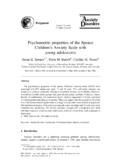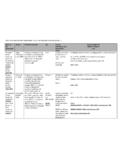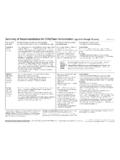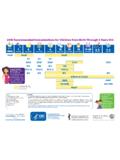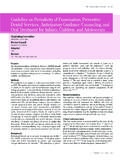Transcription of Attention Deficit Hyperactivity Disorder (ADHD) in ...
1 Page 10 Deficit Hyperactivity Disorder ( adhd ) in children under Age 6 Level 0 Conduct comprehensive assessment and provide psychoeducation about adhd , including clearly defined treatment expectations. Consider co-morbid developmental language Disorder , other learning disabilities (LD), or Autism Spectrum disorders (ASD).Facilitate family engagement, psychoeducation about adhd (evidence-based behavior and educational interventions and medication treatments), and treatment preference assessment. Treatment response should be monitored using rating scales and appropriate safety assessments (vital signs, height, and weight).Level 1 Provide parent management/skills training/or other behavioral intervention at home and/or school for a minimum of 12 2 Initiate monotherapy with methylphenidate 3If methylphenidate is unsuccessful, could consider monotherapy with 4 Consider amphetamine formulations which have FDA indication for ages 3 to 5 years old, but limited clinical trial evidence base; may also consider alpha-2 agonists; but no published data is available.
2 FAfter 6 months of any sustained improvement on any effective medication treatment, taper in order to determine the lowest effective dose and possibility of Recommended: FAntipsychotic medication to treat core symptoms of adhd in absence of Autism Spectrum disorders (ASD). FConcurrent use of two or more alpha-2 agonists. P a g e 11 Deficit Hyperactivity Disorder ( adhd ) in children under Age 6 (continued) adhd Medication Treatment for children under Age 6 Drug NameStarting Dose Recommendation Methylphenidate Formulations1:Short Acting: Ritalin , Methylin , Methylin Chewable Tablets, Methylin Oral titrate as needed to doses not exceeding 1 mg/kg/dayRecommendations extrapolated from thePreschool adhd Treatment Study (PATS) Atomoxetine2(Strattera )10mg/day titrate as needed to doses not to exceed extrapolated from the Kratochvil et al.
3 2011 study Amphetamine Formulations3:Short Acting: Mixed amphetamine salts (Adderall ) d-amphetamine (Zenzedi , DextroStat ProCentra Oral Solution) mg/day titrate as needed to doses not exceeding mg/kg/dayAmphetamine target dose is generally one- half to two-thirds of methylphenidate doseAlpha-2 Agonists4: ClonidineGuanfacineStarting dose not to mg/day (Clonidine) mg/day (Guanfacine)Monitor carefully for excessive sedation, increased irritabilityRecommendations based on expert opinionNotes:1. No FDA indication for children younger than 6 years old; based on Preschool adhd Treatment Study results (Greenhill et al., 2006)2. No FDA indication for children younger than 6 years old; based on Kratochvil, , Vaughan, et al. (2011). A double-blind, placebo-controlled study of atomoxetine in young children with adhd .
4 Pediatrics 127(4) FDA indication for adhd treatment of children 3-5 years old, but no clinical trial study results No FDA indication for adhd except Guanfacine XR in children 6 years and older; no clinical trial study results available for alpha-2 agonist use for adhd in children below age 6 years is no new data on extended release stimulants in preschoolers, but the 2007 American Academy of Child and Adolescent Psychiatry guideline algorithm included extended-release formulations to address compliance concerns (Pliszka et al., 2007).Pa g e 12 Deficit Hyperactivity Disorder ( adhd ) in children and Adolescents Ages 6 to 17 Years OldLevel 0 Comprehensive assessment including a detailed developmental and symptom adhd Rating Scale-IV. F Vanderbilt adhd Diagnostic Parent and Teacher Rating Scales Links to rating scales available at family engagement, psychoeducation about adhd (evidence-based behavior and medication treatments, and educational interventions), and treatment preference assessment.
5 Ensure that treatment response is monitored using rating scales and appropriate safety assessments (vital signs, height, and weight).Level 1 Psychostimulant monotherapy (methylphenidate class or amphetamine class, either short or long acting). If first choice is ineffective try alternate preparation (see table of adhd medications). If supplementation of long acting with short acting psychostimulant required for sufficient coverage, stay within same drug 22a. Atomoxetine or monotherapy with extended release alpha-2 If partial stimulant response, consider combination of extended release alpha-2 agonist with 3 Immediate release alpha-2 4 Diagnostic reconsideration if none of the above agents result in satisfactory treatment. Consider bupropion or tricyclic antidepressant (desipramine not recommended due to safety concerns).
6 Consider other alpha-2 agonist not tried at Level 3 (can be used as monotherapy or combination with other adhd medication classes). Despite limited evidence these medications may be Recommended: FAntipsychotic medication to treat core symptoms of adhd . FConcurrent use of two or more alpha-2 agonists. FConcurrent use of two stimulant g e 13 Deficit Hyperactivity Disorder ( adhd ) in children and Adolescents Ages 6 to 17 Years Old (continued)FDA Approved adhd Medications in children and Adolescents Ages 6 to 17 Years Old Generic Class/Brand NameTypical StartingDoseFDA Max Dose/DayOff-Label Max Dose/DayCommentsMethylphenidate preparationsShort-actingShort-acting stimulants often used as initial treatment in children (<16 kg), have disadvantage of - dosing to control symptoms throughout the mg mg50 mgMethylin 5 mg mg>50 kg: 100 mgRitalin 5 mg mg>50 kg.
7 100 mgIntermediate-actingLonger acting stimulants offer greater convenience, confidentiality, and compliance with single daily dosing but may have greater problematic effects on evening appetite and ER 10 mg mg>50 kg: 100 mgMetadate CD 20 mg mg>50 kg: 100 mgMethylin ER 10 mg mg>50 kg: 100 mgRitalin LA 20 mg>50 kg: 100 mgRitalin SR 10 mg mg>50 kg: 100 mgLong-actingMetadate CD , Ritalin LA and Focalin XR caps may be opened and sprinkled on soft food. Concerta , should not be crushed, chewed or broken. Swallow whole with liquids, non-absorbable tablet shell may be seen in XR is an extended release once-daily 18 mg mg108 mgDaytrana patchBegin with 10 mg patch , then titrate up by patch strength 5 mg mgNot yet knownFocalin XR 5 mg mg50 mgQuillivant XR Begin with 20 mg , then titrate up by 10-20 mg at weekly intervals60 mgNot yet knownPa g e 14 Approved adhd Medications in children and Adolescents Ages 6 to 17 Years Old Generic Class/Brand NameTypical StartingDoseFDA Max Dose/DayOff-Label Max Dose/DayCommentsAmphetamine preparationsShort-actingShort-acting stimulants often used as initial treatment in children (<16 kg), but have disadvantage of - dosing to control symptoms throughout the 5 mg mg>50 kg: 60 mgDextroStat 5 mg mg>50 kg.
8 60 mgProcentra Oral Solution 5 mg mg>50 kg: 60 mgLong-actingLonger acting stimulants offer greater convenience, confidentiality, and compliance with single daily dosing but may have greater problematic effects on evening appetite and sleep. Adderall XR cap may be opened and sprinkled on soft Spansule 5-10 mg mgNot yet knownAdderall XR 10 mg mg (6 -12 y r s .20 mg (13 -17 y r s . )>50 kg: 60 mgVyvanse (lisdexamfetamine)30 mg mgNot yet knownAttention Deficit Hyperactivity Disorder ( adhd ) in children and Adolescents Ages 6 to 17 Years Old (continued)Pa g e 15 Deficit Hyperactivity Disorder ( adhd ) in children and Adolescents Ages 6 to 17 Years Old (continued) adhd Medications NOT FDA APPROVED in children and Adolescents Ages 6 to 17 Years OldGeneric Class/Brand NameTypical StartingDoseFDA Max Dose/DayOff-Label Max Dose/DayCommentsSelective norepinephrine reuptake inhibitorStrattera (atomoxetine)< 70 kg: mg/kg/day for 4 days; then 1 mg/kg/day for 4 days; then mg/kg/dayLesser mg/kg or 100 mgLesser mg/kg or 100 mgNot a Schedule II medication.)
9 Consider if active substance abuse or severe side effects of stimulants (mood lability, tics).Give or divided doses (for effects on late evening behavior). Do not open closely for suicidal thinking and behavior, clinical worsening, or unusual changes in adrenergic agonistIntuniv (guanfacine ER)1 mg then titrate up by 1 mg increments once per weekLesser of mg/kg or 4 mg of mg/kg or 4 mg are not a schedule II medication. Maximum dose limitations may result in low weight- based doses for adolescents and reduced efficacy. Sedation, somnolence and fatigue are common and tend to decline over time. Consider baseline ECG before should not be crushed, chewed or broken before swallowing because this will increase the rate of release. Do not administer with high fat meals due to increased not see effects for 4-6 weeks.
10 Review personal and family cardiovascular off to avoid rebound discontinuing, the total daily dose should be tapered in decrements of no more than mg every 3 to 7 AP VAY (clonidine ER) mg/day at bed mg/day in divided dose mg mg/dayPage 16 Deficit Hyperactivity Disorder ( adhd ) in children and Adolescents Ages 6 to 17 Years Old (continued) adhd Medications NOT FDA APPROVED in children and Adolescents Ages 6 to 17 Years OldGeneric Class/Brand NameTypical StartingDoseMax Dose/DayCommentsAlpha- adrenergic agonistCatapres (Clonidine)< 45 kg: kg , titrate in mg increments , > 45 kg: mg ; titrate in 1mg increments ,or mg; - 45 mg;>45 kg: mgThe following applies to both alpha-2 adrenergic agonists:May be used alone or as adjuvant to another medication class for not combine different alpha-2-adrenergic agents with each otherEffective for impulsivity and Hyperactivity ; modulating mood level; tics worsening from stimulants; sleep e x (Guanfacine)< 45 kg: mg ; titrate in mg increments ; ; > 45 kg: 1 mg , titrate in 1 mg increments may dose in , , - kg:2 mg; - 45 kg;3 mg>45 kg: 4 mgMay not see effects for 4-6 weeks.

